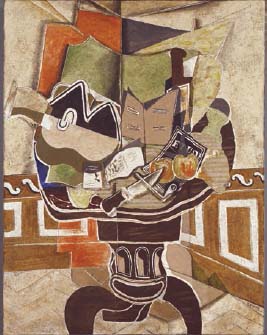From the Industrial Revolution to World War I, C. 1850–1914Early Twentieth-Century Art |
What is Cubism? |
Cubism was a revolutionary development in modernist art that began in the early twentieth century and lasted for decades. Cubism is characterized by fragmented images, or images that have been broken up and viewed from multiple angles. Cubism has its roots in the Post-Impressionist work of Paul Cézanne and Primitivism. It is most closely associated with the work of Picasso and Georges Braque (1882–1963), as well as Juan Gris (1887–1927) and Fernand Léger (1881–1955). Cubism can be considered an attempt to distill complex visual images into an aesthetically unified whole. Cubists artists are interested in capturing the essence of an object and placing it in visual context. The development of Cubism has been linked by some scholars to the massive cultural and social changes taking place during the turn of the century, including enormous changes in technology and industry.
Cubism is divided into various phases, the earliest of which are Analytic Cubism and Synthetic Cubism. Analytic Cubism was developed by Picasso and Braque in 1909. A good example of Analytic Cubism is Braque’s Violin and Palette (1909–1910), in which the image of a violin has been fragmented, as if the violin was made of shattered glass that has been swept up into a pile of crystallike shards. Each “shard” of the violin is visually analyzed in the painting, allowing the viewer to contemplate the physical characteristics of the instrument in a new way. During the Analytic Cubist phase Picasso and Braque painted objects that were almost, but not completely, dissolved into abstraction. By contrast, Synthetic Cubism is characterized by simple forms, less abstraction, and the use of collage, a process in which the artist applies elements (such as newspaper) to the canvas with glue. Examples of Synthetic Cubism include Picasso’s Still Life with Mandolin and Guitar (1924) and his collage piece, Glass and Bottle of Suze (1912).
Cubism was revolutionary for a number of reasons. It was the first modern art movement in which artists experimented with near total abstraction, and it went on to inspire other art movements, including Suprematism, Futurism, and Constructivism.

The Round Table (1929) by Georges Braque is a large, Cubist still-life painting. In it, a bow-legged table is laden with a multitude of objects, including a guitar, apples, a knife, and a newspaper. (Art courtesy The Bridgeman Art Library, © 2013 Artists Rights Society [ARS], New York / ADAGP, Paris.)
